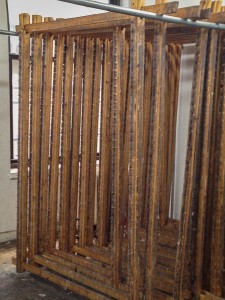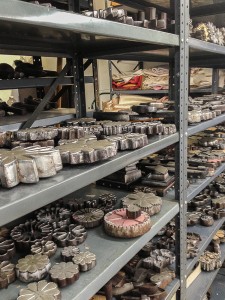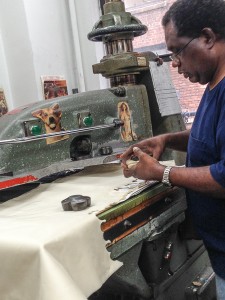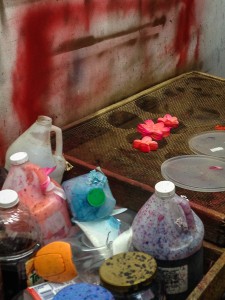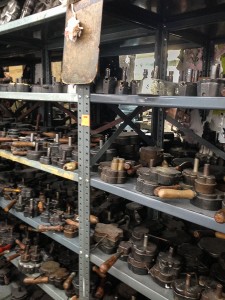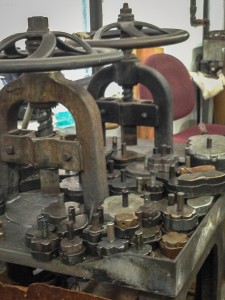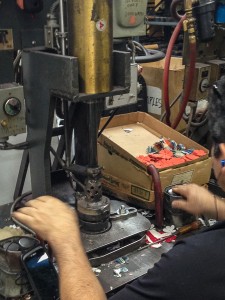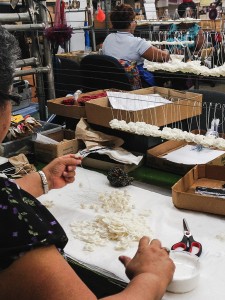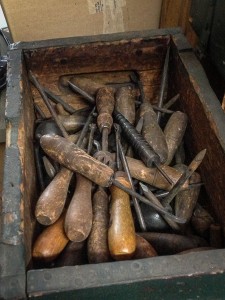On a recent trip to New York City, I was very excited to visit an operating flower factory, Custom Fabric Flowers by M&S Schmalberg. I have been following them on Facebook and love all the new creations that they post. They said they offer tours of their flower factory, so I made an appointment and stopped in to see how the magic is created!
When I arrived, I was greeted by Adam who is the son in this 4th generation, family owned company. The show room was filled with all kinds of examples of the flowers they make, but there would be time for browsing later. We left the show room and headed straight to the area where the flowers are made. It turns out that making flowers in a factory is very similar to making flowers by hand. The individual steps are very similar. The factory has large machinery to help, but it’s still a very labor intensive process. The first step is to stiffen the fabric. It’s stretched on the racks below, sprayed with stiffener and left to dry.
Next, the die is chosen for cutting out the shape of the flower petals. There were literally hundreds of dies! You can see on the top shelf of the photo below that some of the dies have a large post on them. In the past, multiple layers of fabric would be set up, the die placed on top, and a hammer would be used to cut out the shape.
Thanks to modern machinery, hammers are no longer necessary. The left shot below is of one of two machines that they have for cutting out the shapes. The process is still the same: layer the fabrics, place the die, then swing the arm over both and the arm presses down to cut out the shapes. The photo on the right shows an employee cutting out some flowers.
The factory also has a dye room and I got to see that too. As you can see in the photo below on the left, the petals have been cut out at this stage and the edges are being dyed. The fabric could have been dyed first too. For example, I picked up some lovely velvet flowers that had been tie-dyed in rich blues and greens. These are definitely one of my great finds.
From here, the flowers need to be shaped. There are equally as many molds (photo on the left) to choose from, each with a top and bottom, or male and female part, to shape the flowers. Historically, a manually operated machine was used, shown below on the right. The tabletop is heated (so the whole thing was radiating heat), the bottom of the mold was placed on the table underneath the big wheel, the top of the mold was placed in the shaft, and the wheel was turned to create the pressure needed to form the shape. As you can imagine, this was also very labor intensive and not an enjoyable job since you are working over the equivalent of a hot stove all day. Today, this is used to keep the molds warm while the workers shape other flowers.
To shape the flowers, they now use a heated hydraulic press, but it is the same process. The bottom of the mold goes in the middle of the plate, the top of the mold with the shaft goes in the top of the machine. One flower petal is placed on the bottom part of the mold. With the push of a button, the top comes down, holds for a few seconds to shape the petal, and then it releases. The worker places the shaped petal in his ever-growing collection of shaped petals!
From here, the flower is assembled. A number of ladies were taking wire and stamens as needed, gluing the petals to the wire, and letting them dry. You can see the individual petals on the table and the completed flowers hanging from the line above.
After the tour, I met Warren, the father in this family owned business. I got to look through all the flowers that they had in stock (hundreds!) and pick some out to take home with me. Warren told me the stories about the flowers I chose (many hand dyed, some based on Dior flowers, etc). He also shared a treasure chest full of flower making tools from a company that went out of business. So many interesting tools!
If you are in New York City, I highly recommend stopping by Custom Fabric Flowers and checking it out! They are located at 242 West 36th Street, 7th Floor, New York, NY 10018.

